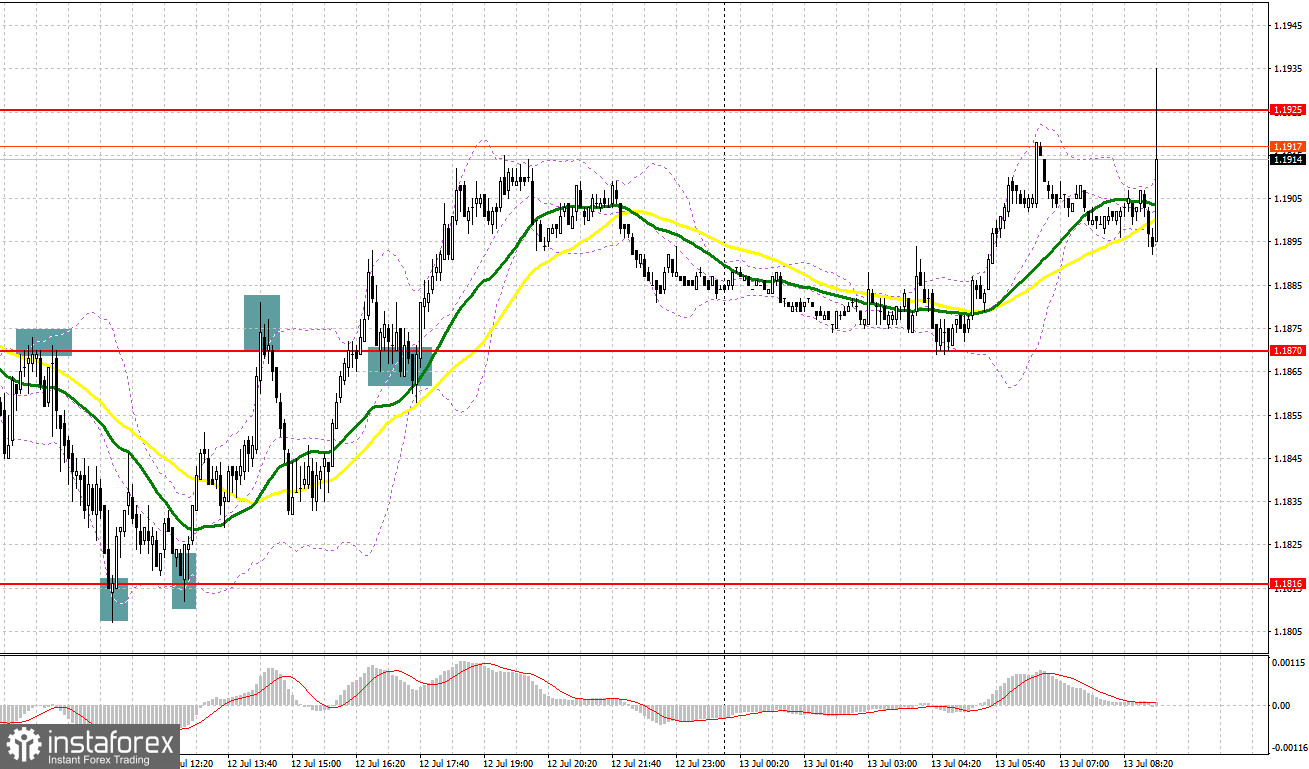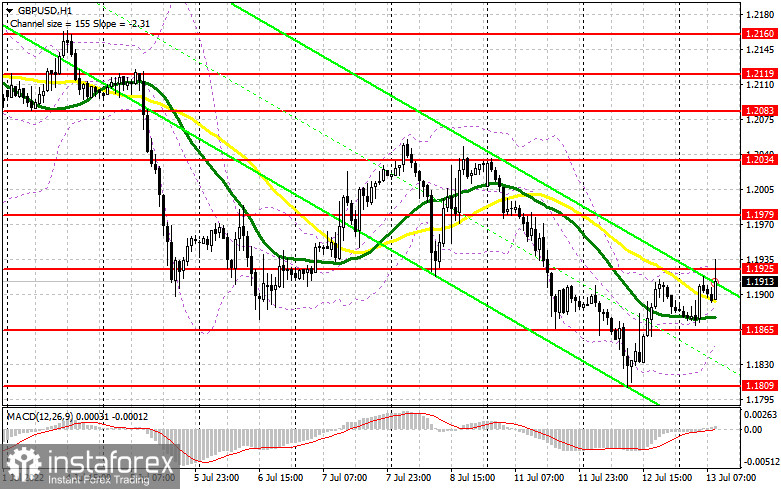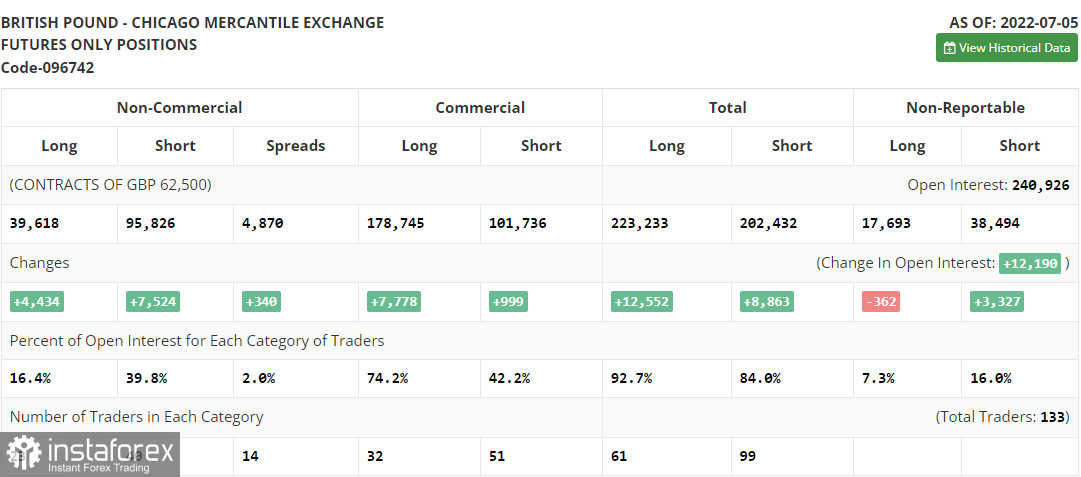Quite a lot of profitable signals for entering the market were formed yesterday. Let's take a look at the 5-minute chart and see what happened. I paid attention to levels 1.1870 and 1.1816 in my morning forecast and advised making decisions from it. Failure to return back to 1.1870 in the first half of the day resulted in forming a false breakout and a signal to sell the pound, which resulted in a large fall to the 1.1816 area, making it possible to take about 50 points of profit. Several failed attempts to surpass the area below 1.1816 led to buy signals, each of which showed a rise of just over 30 points. The pair sharply moved to 1.1870 in the afternoon, where the bears immediately showed themselves, forming a false breakout at this level. The signal for short positions brought about 40 points of profit. And by the middle of US trading, the bulls still managed to seize the resistance of 1.1870, and its breakthrough with a reverse test from top to bottom became a buy signal, which brought another 40 points of profit.

When to go long on GBP/USD:
Today, traders will focus on data on the UK economy, which can help bulls cope with the nearest resistance at 1.1925. We can only count on growth above 1.1925 if we receive strong reports on the volume of industrial production, the trade balance and in particular - the UK GDP. In case we receive disappointing data and the pound falls in the first half of the day, the bulls will definitely show themselves in the immediate support area of 1.1865. Forming a false breakout there will be an excellent signal to open long positions in order to move up to the nearest resistance area of 1.1925, on which quite a lot depends. There are moving averages passing slightly below 1.1925, which will limit the upward potential. Therefore, a breakthrough of this level will create a more powerful upward momentum. A breakthrough and test of 1.1925 will provide a signal for long positions while counting on a sharper jump and update at 1.1979. A similar breakthrough of this level after strong reports will lead to another entry point into longs with the prospect of exiting at 1.2034, where I recommend taking profits. But don't forget, the US inflation report will be released today, which can make a lot of noise and can limit the pair's upward potential. A more distant target will be the area of 1.2083, which will be a clear application for building a new upward trend.
If the GBP/USD falls and there are no bulls at 1.1865, this will increase pressure on the pair. In this case, I recommend postponing long positions to 1.1809 – the last level, a breakthrough of which will cross out all bulls' hopes for an upward correction. I advise you to buy there only on a false breakout. You can open long positions on GBP/USD immediately for a rebound from 1.1742, or even lower - around 1.1647, counting on correcting 30-35 points within the day.
When to go short on GBP/USD:
Today, the bears' main task is to protect the important resistance at 1.1925, which may be tested immediately after the release of UK data. But in order to regain control of the market, bears need to move below 1.1865 as quickly as possible, which will not be easy to do, given how bulls are in the mood for a correction. In case GBP/USD grows in the first half of the day after receiving the GDP data, forming a false breakout at the level of 1.1925, where the moving averages pass, will provide the first entry point into short positions in continuation of the bearish scenario and with the prospect of a return to 1.1865. You need to understand that the downward movement after a false breakout at 1.1925 should be quite rapid. Consolidation below 1.1865 and a reverse test from the bottom up will greatly affect the bulls' stop orders, which create another entry point for selling the pound with a decrease to 1.1809, where I recommend partially taking profits. A more distant target will be the area of 1.1742, the test of which will be evidence of the resumption of the downward trend.
If GBP/USD grows and there are no bears at 1.1925, or there are weak shorts after a false breakout in the face of good statistics, the situation will change in the bulls' direction. In this case, I advise you not to rush into longs. Only a false breakout in the area of the next resistance at 1.1979 will provide an entry point into short positions, counting on the pair's bounce down. If there is no activity there, another upsurge may occur amid the removal of speculative sellers' stop orders. In this case, I advise you to postpone short positions until 1.2034, where you can sell GBP/USD immediately for a rebound, based on a rebound of the pair down by 30-35 points within the day.

COT report:
An increase in both short and long positions was recorded in the Commitment of Traders (COT) report for July 5, but the former turned out to be much larger, which led to an increase in negative delta. Another attempt to buy out the annual low failed after it became obvious that the Bank of England intends to continue to fight inflation by raising interest rates, which will definitely slow down the British economy even more and push it into recession. The crisis in the cost of living in the UK continues to flare up more and more, and the recent resignation of British Prime Minister Boris Johnson is unlikely to help quickly deal with this. There are no prerequisites for buying the British pound, except for the fact that it has updated the next annual lows. The policy of the Federal Reserve and its pace of raising interest rates in the US gives the dollar much more support, since there are no such problems with the economy. This was confirmed by recent data on the US labor market for June this year. The COT report indicated that long non-commercial positions rose by 4,434 to 39,618, while short non-commercial positions jumped by 7,524 to 95,826, which led to an increase in the negative value of the non-commercial net position to -56,208 from level -53,118. The weekly closing price decreased and amounted to 1.1965 against 1.2201.

Indicator signals:
Moving averages
Trading is below the 30 and 50-day moving averages, which indicates the continued downward movement of the pound.
Note: The period and prices of moving averages are considered by the author on the H1 hourly chart and differs from the general definition of the classic daily moving averages on the daily D1 chart.
Bollinger Bands
In case of growth, the area of 1.1905 will act as resistance. If the pair goes down, the lower border of the indicator around 1.1845 will act as support.
Description of indicators
- Moving average (moving average, determines the current trend by smoothing out volatility and noise). Period 50. It is marked in yellow on the chart.
- Moving average (moving average, determines the current trend by smoothing out volatility and noise). Period 30. It is marked in green on the chart.
- MACD indicator (Moving Average Convergence/Divergence — convergence/divergence of moving averages) Quick EMA period 12. Slow EMA period to 26. SMA period 9
- Bollinger Bands (Bollinger Bands). Period 20
- Non-commercial speculative traders, such as individual traders, hedge funds, and large institutions that use the futures market for speculative purposes and meet certain requirements.
- Long non-commercial positions represent the total long open position of non-commercial traders.
- Short non-commercial positions represent the total short open position of non-commercial traders.
- Total non-commercial net position is the difference between short and long positions of non-commercial traders.
 English
English 
 Русский
Русский Bahasa Indonesia
Bahasa Indonesia Bahasa Malay
Bahasa Malay ไทย
ไทย Español
Español Deutsch
Deutsch Български
Български Français
Français Tiếng Việt
Tiếng Việt 中文
中文 বাংলা
বাংলা हिन्दी
हिन्दी Čeština
Čeština Українська
Українська Română
Română

